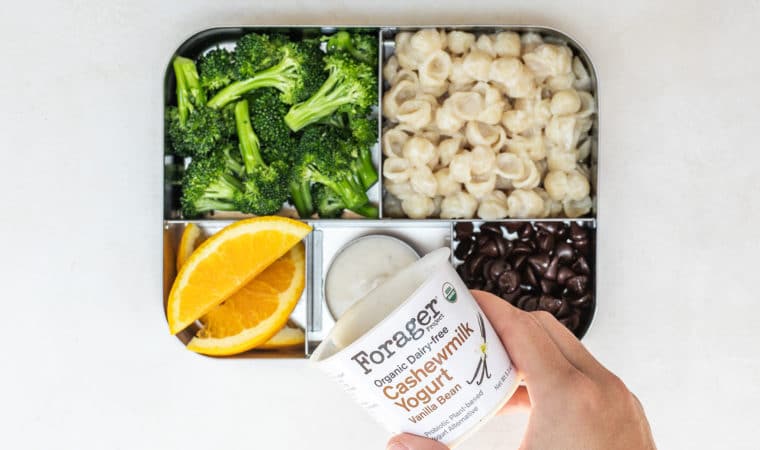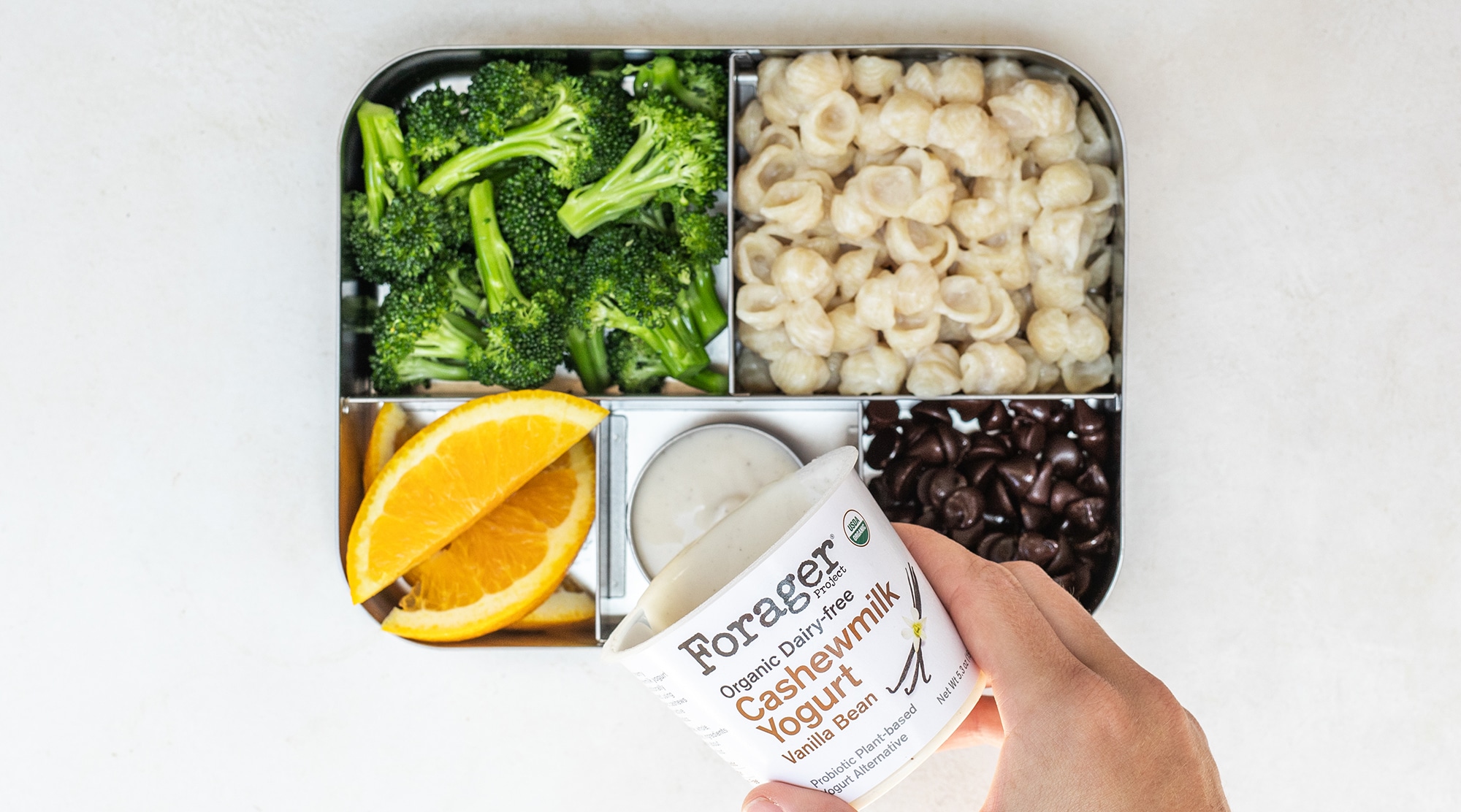



With back-to-school season in full swing, packing a healthy, produce-rich plant-based meal for kids can seem like a daunting task for many parents—but it doesn’t have to be. We asked Alex Caspero, Registered Dietitian Nutritionist and plant-based mama for her advice on ensuring your child is getting enough protein, calories, and nutrients to power them through the school day.
Protein tends to be the number one concern of plant-based diets, but the good news is that you likely don’t have to worry. The average American child consumes 3x the recommended amount of protein per day1, with vegan children consuming almost 2x the recommended amount2. Protein is in every single plant food—as long as you are consuming a varied plant-based diet, you will get all of the essential amino acids that you need. Protein-rich plant-based foods include beans and legumes, plant-milks, tofu, whole grains like oatmeal, whole-wheat bread and pasta, quinoa, nuts, seeds and nut butters.
The average 7-year-old child needs roughly 20g of protein per day; one peanut butter sandwich with 1 tablespoon of peanut butter and two slices of whole wheat bread contains a little less than 1/2 of their protein needs for the entire day. Throw in a smoothie for breakfast, a Forager Project kids yogurt pouch as a snack, and spaghetti for dinner, and your child has easily met their protein needs for the day—and then some.
To ensure you are meeting your child’s overall macronutrient needs for protein, fat and carbohydrates, I recommend focusing on serving whole plant-foods often, with specific focus on beans and legumes, whole grains and healthy fats like nuts, seeds, avocados and plant oils like olive oil. As younger children especially need higher levels of calories from fat than adults for adequate brain growth3, focusing on serving these foods often will ensure proper growth and development from plant-based lunches.
After protein, the top concern from all parents is usually around the topic of selective eating. Many parents know their kids should be eating more fruits and vegetables and it can be frustrating to serve them nourishing foods, only to have them go to waste. It may be why only 1 in 10 kids—and adults– eats the recommended number of fruits and vegetables per day.
For new plant-based eaters, starting slow often leads to better outcomes—especially with kids. Have them identify 2-3 plant-foods they already love and start serving them more often. With new foods, involve your children as much as possible to increase exposure. That can mean helping them pick out new fruits and vegetables in the store, preparing a new recipe together with you or picking out a new snack to try in their lunch box.
For packed lunch, swap sandwiches for pasta salads with a vegetable or two, bento boxes with various produce, and mason jars stuffed with salads. Try a deconstructed burrito bowl for lunch one day with shredded lettuce, seasoned black beans, rice, corn and salsa.
Packing lunches after making (and cleaning) dinner can feel like an overwhelming task most nights, so having a clear formula makes it easy to quickly pack for the next day. Our formula includes a main course (sandwich, salad, tortilla roll-ups, thermos meal, rice cake with nut butter), a veggie (carrot sticks, bell pepper strips, corn), a fruit (cut melon, berries, thawed from frozen mango cubes, whole apple or clementine) and a simple snack side, like applesauce or bars. In a convenient on the go format, drinkable yogurts are rich in probiotics and come in delicious fruity flavors that kids love like strawberry, mango, strawberry banana and berry berry.
Creating a “school lunch basket” or “snack drawer” in the fridge makes lunch packing almost effortless. Stock the shelves with healthy grab-and-go items like whole-grain pouches and applesauce pouches.
In the fridge, stock a dedicated section with individual containers of hummus, pre-cut veggies, and Forager Project’s individual Yogurt Cups, Yogurt Pouches and Yogurt Smoothies. Having a special section in the fridge allows kids to pick out which snacks and sides they want for lunch each day—increasing the likelihood that they’ll eat it, while reducing the workload for parents.
Setting kids up for success at lunchtime often starts with breakfast. Many kids have a hard time waking up and focusing in the morning, especially with early school start times. If a full breakfast meal isn’t appetizing to them at 6:30 AM, consider a smoothie instead.
To save time during busy mornings, make smoothie packs ahead of time which can be frozen and used throughout the week. Getting kids involved in placing their favorite fruits – and leafy greens like spinach or kale—into the packs is a good way to have conversations around the various colors of fruits and vegetables they are putting in. A great plant-based staple for breakfasts are Forager Project’s cashewmilk yogurts. These add creaminess and probiotics to any smoothie, helping kids maintain a healthy gut microbiome.
As fat, protein, and fiber all contribute to fullness, you’ll want to make sure that whatever breakfast choice you’re offering contains at least two out of the three. On busy mornings, I’ll often serve my children nut butter sandwiches for enjoying on the way to school or overnight oats that I prep the night before.
Getting kids involved in the kitchen is a great way to combat picky eating and gently teach them about healthy foods. Kids of all ages can help assemble their lunch box. Simple tasks to help get kids involved include slicing cucumbers, peppers and celery with kid-friendly knives, making nut-free trail mix bags with Grain-free Os cereal, raisins, unsweetened dried blueberries, pepitas, sunflower seeds and dark chocolate chips, using cookie cutters to cut out shapes for sandwiches and placing items in their bento boxes.
It doesn’t take much to make a lunch box more fun and a little creativity goes a long way. Rolling up a PBJ sandwich in a tortilla and slicing it into pinwheels, cutting a chickpea-salad stuffed sandwich into a fun shape or skewering berries onto toothpicks for dipping into Forager Project’s Yogurt are easy ways to get out of any lunch box rut.
Sources

Alexandra Caspero MA, RD, RYT is a Registered Dietitian Nutritionist and creator of the award-winning website, Delish Knowledge. She is also the author of Fresh Italian Cooking for the New Generation and co-author of the bestselling book, The Plant-Based Baby and Toddler. Alex is co-founder of Plant-Based Juniors, an evidence-based platform that helps parents navigate the world of plant-based prenatal and pediatric nutrition.